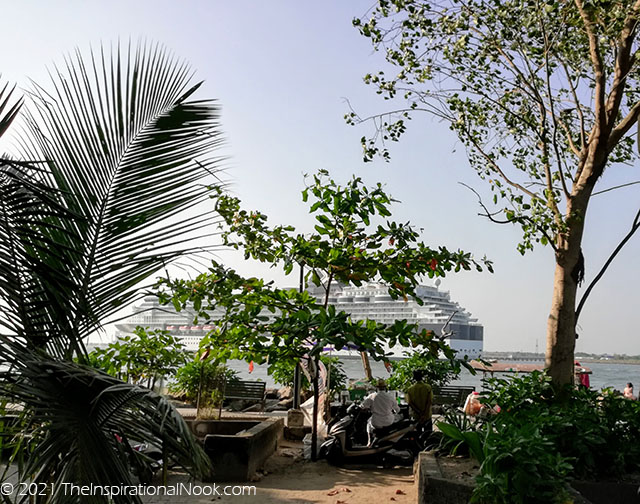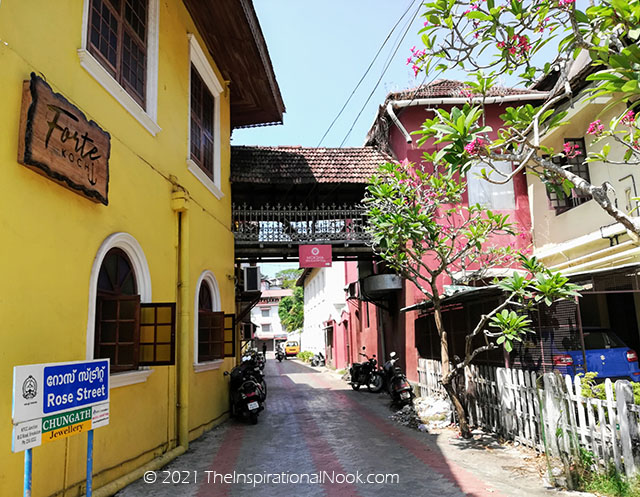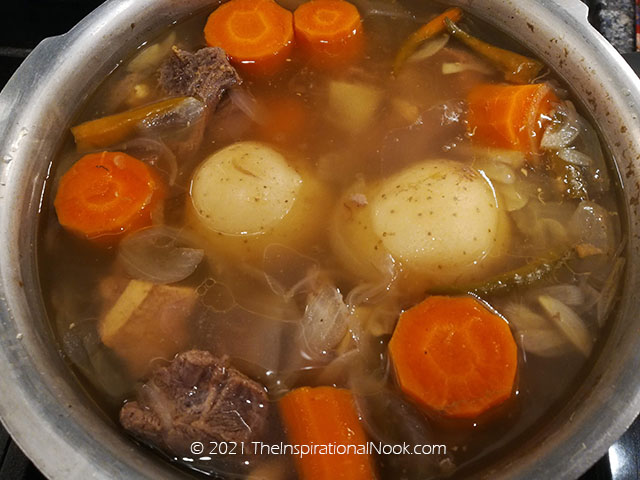Kerala Mutton Stew with Coconut Milk | Fort Cochin Delights
I'm so lucky to have a family connection with Fort Cochin that goes back generations. Which means I get to visit Fort Cochin often and revel in all the delights that this historic little hideaway has to offer. From traipsing down cobble stoned streets lined with Dutch-style homes and rushing to catch sunset on the beach to getting my fill of all the local traditional delicacies that this delightful coastal village has to offer. One of my favourites is Kerala Mutton Stew or 'Ishtoo,' to be more exact with the pronunciation, eaten with frilly appams (or hoppers, as my family calls them). But more on that it in a minute.
 |
Have you been to Fort Cochin? What a fascinating place, it is! This tiny, sleepy fishing village in the rightly named land of 'God's Own Country,' aka Kerala, is on the map for all the right reasons.
Dating back to the 1500s, Fort Kochi was at different times over the last few centuries, home to Dutch, Portuguese and British settlers. And their influence is evident in the colonial architecture, food, religion and culture that resonates in this little town, making it a special place in India. Fort Kochi's most recent claim to fame is that the international Biennale art festival, the Kochi-Muziris Biennale takes place over here every 2 years, with local and international artists showcasing their art on heritage properties that have been preserved and turned into gallery spaces. That's the time we generally stay away, since all and sundry descend on this sleepy little town and awaken it from its reverie with a big BANG.
I prefer Fort Kochi in its dreamy state (which is at all other times when the Biennale is not on). Super dreamy times are on weekday evenings, once the massive cruise liner that visits a couple of times a week, sounds its horn and sails away taking with it all the day tripper tourists. So long, farewell, auf wiedersehen goodbye.
 |
| Goodbye cruise liner. |
Don't get me wrong. I don't mind sharing Fort Kochi with the tourists. Strolling down the charming and sweetly named lanes of Rose Street, Princess Street, Peter celli Street, Napier Street, Lily Street, there's room for us all.
 |
| Cobbled and frangipane lined Rose Street in Fort Kochi (Fort Cochin), Kerala, India. Koder house in the background with its over the street covered passageway connecting buildings. |
I most enjoy the intrepid tourist who strikes up conversation at the most unlikely of places- while I'm have a cup of tea at Teapot Cafe, riding the jangar (ferry) to go to Vypeen or browsing the book shop at Loafer's Corner.
That's when I can spout a little local wisdom and shower them with a sampling of local titbits of how my grand aunts used to play as children on the Teapot Café loft, how if we are lucky we will see dolphins swim alongside our ferry, how grand the processions are for Our Lady's Feast, how the previous generations spoke Portuguese, how Koder House run by the Jewish Koder family sold the finest of wares back in the day... Yes, there is more to Fort Kochi than dining at Brunton Boatyard, visiting Old Harbour Hotel, getting ayurvedic massages and visiting the Chinese fishing nets. And those rich, untouchable souvenirs can only be found by chatting with the locals.
 |
| Teapot Cafe- a charming place in a heritage home to stop for a cuppa. |
Anyway, as I was saying, my favourite time to stroll around in Fort Kochi is after the cruise ship has left for the evening. A certain indescribable calmness and quietness sets in. I enjoy a lazy amble along the waterfront to catch the sunset, followed by a slow walk past St. Francis Church (where Vasco da Gama was buried in the 1500s), before turning in to walk along the length of the Maidan (football field). A lone autorickshaw may putter past and a few other amblers might nod to one another as the birds in the rain tree canopies above get ready to settle in for the evening with a few approving calls.
 |
| St. Francis Church in Fort Kochi, where Vasco da Gama was buried in 1524. A classic example of Indo-Dutch architecture. |
I might stop at the Cochin Club for a drink and a snack (they make the best french fries ever! But sorry, it's not open to the public.) I may stop by the lovely old Dutch bungalow, David Hall Gallery and Cafe or Bastion Bungalow Cafe and sit under the fig tree, but most of the time I make my way home for my meals. For as lovely as the restaurants are in Fort Kochi, serving up international and fancy Indian-fusion cuisine, my heart (and stomach) is set on traditional Kerala style food... which is a bit like looking for a needle in a hay stack here. So, when my stomach rumbles, its best that I hurry home. Since the best hyper local food that I can get my hands on... is at home, in my family's 400 year old Dutch style home, prepared by our local cook in the kitchen, deep in the back of the house.
Every time I visit, I can always count on the cook preparing my favourite Kerala Mutton Stew! Juicy pieces of mutton on the bone with carrots, potatoes and peas, simmered in a light coconut gravy, fragranced with cinnamon, clove and cardamom and lightly spiced with green chilies. Always served with hoppers (appams) or string hoppers (iddiappams) and an absolute must to be eaten with fingers.
RECIPE: How to Make Mutton Stew Kerala Style
Ingredients:
To Marinade:
☐ Vinegar
☐ Salt
☐ Pepper powder
☐ Turmeric powder
☐ 6 slit green chilies
☐ 1 1/2 inch ginger root, sliced
☐ 2 cloves of garlic, sliced
☐ 1-2 small/ medium whole potatoes
☐ 1 carrot, thickly sliced
☐ 1 onion, sliced
☐ 15 pepper corns
☐ 2 green cardamoms
☐ 8 cloves
☐ 1 inch cinnamon stick, broken into 3 pieces
☐ Curry leaves
☐ 1 teaspoon corn flour dissolved in 1/2 cup of water
Step by Step Instructions:
Step 1: Marinade Mutton
- Marinade for mutton pieces for 30 minutes in 2 teaspoon of vinegar, salt, pepper and a pinch of turmeric powder.
Step 2: Make the meat and vegetable broth
- Cook mutton in pressure cooker with sufficient water, along with the whole potatoes, carrots, garlic, ginger, green chilies and 1/2 the sliced onions to make the mutton broth.
- (Pressure cooker timing for mutton: Cook for 4 whistles on medium heat. Then lower flame and cook for 5-6 minutes. Open after 5 minutes and check for doneness. Depending on the toughness of the meat, it may require to be cooked further for another 2 whistles).
 |
| After the meat and vegetables are cooked in the pressure cooker. |
- Remove 1/2 the broth from the pressure cooker and set aside in a small saucepan for later.
- Cut potatoes into chunks.
Step 3: Fry onions and whole spices
- In a large vessel, heat oil until shimmering. Add the remaining sliced onions, pepper corns, green cardamoms, cloves, cinnamon. Fry onions until golden brown. Then add curry leaves and turn the stove off.
- Add the mutton pieces, vegetables and broth from the pressure cooker.
Step 4: Add coconut milk
- On a low flame, slowly add coconut milk to the stew starting with thin coconut milk first. Add only about 1/2 of the can.
- Do not let the stew boil.
- Continue to heat without stirring. Watch the stew carefully. At the first signs of movement on the surface of the stew, or as the first bubble breaks the surface, switch off the stove.
- Add 1/4 teaspoon of vinegar.
Step 5: Thicken stew
- Dissolve 1 teaspoon of corn flour in 1/2 cup of water.
- Add this corn flour mixture into the broth that you set aside earlier in a saucepan.
- Boil to thicken the mixture. Then pour this thickened mixture into the stew and stir.
- Add frozen peas to the stew.
Enjoy with bread or appams.
If you liked this recipe, then try my other Anglo Indian Recipes from Fort Kochi.
- Fried Sweet Kerala Plantain or Nendran Pazham for breakfast
- Dry Prawn Fry or Unaakka Chemeen for lunch.
- Coconut Panrolls for teatime.
- Coconut Rice and Ball Curry for dinner.
Or visit 'My Cookbook Index' for a complete menu.